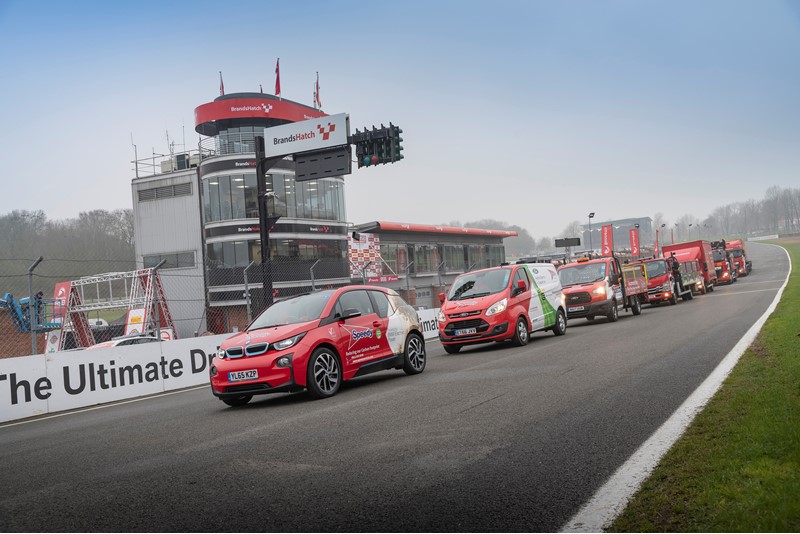Can you design out risk? It’s a question that strikes at the heart of the safety and risk management policy employed by Fleet News Awards winner Speedy Asset Services.
Every vehicle is procured with safety as its key criteria; every health and safety incident is reviewed and analysed to find the root cause; every driver is risk-assessed to see what they could do better or differently.
Speedy explores every avenue to answer: could the incident have been avoided?
Safety is a core value with a philosophy set at board level. “It’s an industry thing,” explains Mark Woodworth, Speedy head of transport and logistics.
He adds: “The building world is hard to get into if you aren’t safe, so it’s the right thing to do in fleet as well.”
The approach to risk is identical, whether an employee is entering a construction site or sitting behind a wheel: what happened? Why did it happen? Could it have been avoided if different action was taken? What’s the likelihood of it happening again?
“We identify the risk and the size of the risk. Then we try to get rid of it through training or we design it out,” says Woodworth.
However, this isn’t a short-term, quick fix; it has taken Speedy four years to get the safety culture to where it is – and it continues to make enhancements and improvements to its processes to drive out risk.
Root cause analysis has been the mainstay of the policy for the past three years and consists of two elements: why did the incident happen/how can it be avoided in future; and, what was the driver doing mentally?
The latter often gets to the real source of the problem. For example, if a driver was on the phone to their manager, what was the reason for the call and what pressure was put on them to take the call?
Complacency and rushing
The two most common causes are complacency – ‘I didn’t think it would happen to me’ – and rushing, either because they don’t care enough or they care too much.
The second is often down to pressure or a desire to get product to the customer on time, which results in speeding. In these instances, Speedy looks at the other elements involved in fostering that behaviour, working up the command chain.
Often this can be down to consequences of business decisions taken elsewhere.
For example, Speedy introduced a ‘capital commitment’ to deliver in London within two hours but it put extra pressure on the drivers which could only be resolved by a change in the commitment or investment in more vans to provide additional resource. The commitment is now delivery within four hours.
“When we launch new marketing initiatives or tender for business, I’m more involved now than ever,” says Woodworth. “We need to know the resource and training needed to meet the terms of the tender.”
Cognitive behavioural therapy
He has recently evolved the root cause analysis to include cognitive behavioural therapy (CBT), which has made an immediate impact with a number of drivers.
One, a top sales lady who had 13 accidents, all relatively minor, was rated a safe driver by every driver assessment she took, by both internal and external trainers.
“An ex-police driver trainer identified the problem – he said she was technically a very good driver, so good that she’d only had 13 accidents,” Woodworth recounts. “If she hadn’t been so good, she would’ve had 23 accidents. The issue was her 1,000-mile mentality, which meant she wasn’t concentrating on the driving.”
Since she underwent CBT training nine months ago, she hasn’t had a single crash. “It was all about how she defines risk on the road,” Woodworth adds.
“It’s early days for CBT and it’s expensive, but you can’t put a price on safety.”
Speedy operates a fleet of 2,005 vehicles – 520 cars, 1,240 vans and 245 trucks – an increase of more than 400 (primarily vans) in the past year due to acquisitions and business growth.
“We have a vehicle fleet that is designed to a level where there’s not much more we can do,” says Woodworth.
Examples include mitigating a perceived risk to staff working on flatbed vehicles during darkness by installing orange running lights along the edge of the flatbed and red LED strip lights up both sides of the beavertail. They complement the fall arrest system.
Decision tree
The decision tree for new vehicles starts with fit-for-purpose, then safety and finally the financial consideration. Once procured, Speedy adds another layer of safety technology with telematics (Masternaut) and five-way cameras (Vision Track).
They have both paid for themselves many times over with reductions in crashes and crash severity, although they also raise false alarms from time to time.
“We spend a lot of time investigating issues and we have review meetings with the chief executive every two months to look at each site,” says Woodworth.
“At our Glasgow depot, we saw an increase in speeding. We spoke to the drivers who said they weren’t speeding. But it was a reporting issue – a speed limit had changed (increased) but the system wasn’t updated.”
He has had similar discrepancies with driver-facing, in-cab cameras that are currently on trial.
“We were getting false positives which said the driver wasn’t alert, but the issue was the bouncing XF seats (the driver’s eyes weren’t always picked up by the camera),” he explains. “Once these are ironed out, it should be beneficial.”
Trucks have cameras fitted front, rear, left and right and they have led to a reduction in claims volume and value. They also help Speedy to counter fraudulent claims as the footage can prove its vehicles were not at the scene of an alleged incident or that drivers were driving correctly.
And, if an incident does occur, Speedy can instantly view the recording and provide evidence to its insurers, allowing them to settle claims quickly and efficiently.
While the drivers know their actions are caught on camera, they also recognise the benefits – particularly the younger drivers who “love them”, says Woodworth: “It helps them to drive safely and also protects them. We’ve seen a change in mentality – they want the driver aids.”
Claims volume fell by 15% last year, although the cost increased 10% because the fleet has undergone a renewal programme – newer vans with more safety equipment are more expensive to repair.
Acquisitions have brought new drivers onto the fleet, which has prompted Speedy to refine its mandatory training matrix.
This states that no one can drive for business until they prove they can drive safely and have undergone load safety and manual handling training.
 All new starters attend a day of e-learning Speedy’s code of conduct, culture and values, FORS and efficient driving. The induction consists of around nine online modules, many a short-sharp 15-minute blast of information.
All new starters attend a day of e-learning Speedy’s code of conduct, culture and values, FORS and efficient driving. The induction consists of around nine online modules, many a short-sharp 15-minute blast of information.
They spend the next couple of days in the training centre and then finally undergo task-based training.
“If they are a fitter driving a van, then three days is enough to be a driver,” says Woodworth. “But if they drive a drop-side, for example, they have to do tail-lift training, load security and towing. And, for heavier trucks, there’s use of winches, beavertails, etc. It is more task-based at that level.”
When HGV drivers finally go out onto the road, they are put in small trucks before they advance to large ones, with their progress constantly monitored.
Vast number of training modules
In total, Speedy has a vast portfolio of almost 50 training modules, ranging from 15 minutes to a couple of days.
Yet, all the vehicle technology, induction training and driver training doesn’t eliminate crashes. Here, the next phase of the risk management programme comes into play.
The post-accident review group is Woodworth plus road risk manager Gareth Jones, senior management and HR. They meet weekly to discuss possible root causes to every incident. Prior to the meeting, a lengthy discussion takes place with the driver during which data about the incident is reviewed.
If the driver is deemed to be at fault, the review enters three possible phases: online driver risk assessment, classroom training and one-to-one driver training with internal or external RoSPA (Royal Society
for the Prevention of Accidents) trainers.
Speedy employs three driver trainers – they spend 75-80% of their day training, the rest on inductions – and they have access to all the driving data to prepare bespoke courses based on the incident. CBT is the final option once the review has concluded.
“If they have had a bad crash, a total loss or they are anxious on the road, we go straight to one-to-one training, before they go back on the road,” says Woodworth.
Off-road time is big issue
Preventing accidents is a moral and social responsibility priority for Speedy, but it also has supplementary benefits, including reducing vehicle-off-road time – “a big issue”, according to Woodworth.
He is working with Ford to pull live data from the vehicle’s CanBus, including oil condition. This is a growing concern with longer service intervals on vans and enables Speedy to predict when the van needs to be booked in for an oil change.
“We can’t replace our van with a similar one, so, if it is off the road, we can’t do the job,” Woodworth says.
Once he is happy with the quality of the data, it will be fed directly to Speedy’s maintenance provider, Lex Autolease.
The CanBus data can also notify the fleet team about warning lights, such as seatbelts or screenwash, and Speedy can adjust when it receives the alert.
For example, the brake pad warning light might come on in the vehicle with 20% left, but Speedy will set the alert for 25% so when a driver rings up, they will already have been allocated a spare van.
Ultimately, Speedy will look to access the fault codes; the warning light is the first step.
While Speedy has not been able to fully design out risk through vehicle specification, use of technology and its comprehensive training programme, it is forever finding new ways to tackle the issue with evident success.
“It’s a little bit of everything that goes into safety,” says Woodworth.
“No one goes to work to not go home at the end of the day.”
Grey fleet ‘treated the same’ as company car drivers
Speedy limits the use of grey fleet, but it has still seen a doubling in size to 120 over the past year.
Mark Woodworth puts it down to the rate of benefit-in-kind taxation and a reduction in choice on the car fleet.
Every month, the fleet team gets a report from its Jaama system for the current period and the next four weeks with alerts on expiry dates for business insurance, servicing, road tax and MOT.
Failure to supply the correct information by the employee leads to a cessation of mileage reimbursement.
This data is complemented by a new mileage capture app (The Miles Consultancy) which requires the driver to confirm their vehicle is road legal, has the correct insurance and that there have been no changes to their driving licence every time they log on.
Grey fleet employees, who undergo the same training regime as company car drivers, must also agree that their cars can be spot checked at any point for roadworthiness and compliance with the guidelines in the company car policy.
As Woodworth says: “They are company car drivers using their own car so they are treated the same.”
Woodworth on...
Training evolution
Speedy is constantly developing its training programme, adding new modules to meet new threats and challenges. It now incorporates almost 50 courses.
One of the latest is counter-terrorism, an issue that has become one of the company’s most pressing concerns.
Every driver has now undergone the counter-terrorism training, which focuses on risks such as vehicle security, identifying threats, idling and leaving keys in the cab.
“We are very safety-conscious, but we are becoming more risk-conscious – there’s a subtle difference,” says Mark Woodworth.
“It’s more than just safety. If you leave a van idling, the driver is safe, but someone else might not be if that van is stolen and used for terrorism.”
Speedy is also considering implementing Driver First Assist, a not-for-profit scheme which trains drivers to deliver life-saving first aid if they arrive at the scene of an accident before the emergency services.
The company plans to run the proposition past drivers first to gauge their views, but Woodworth expects to introduce the training in March/April next year.

















Login to comment
Comments
No comments have been made yet.